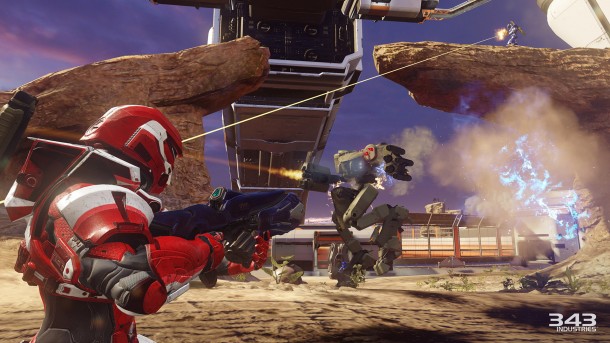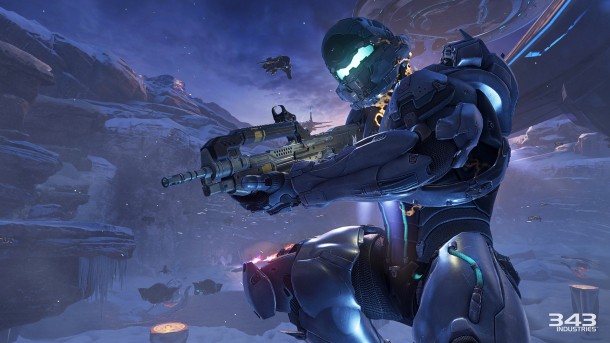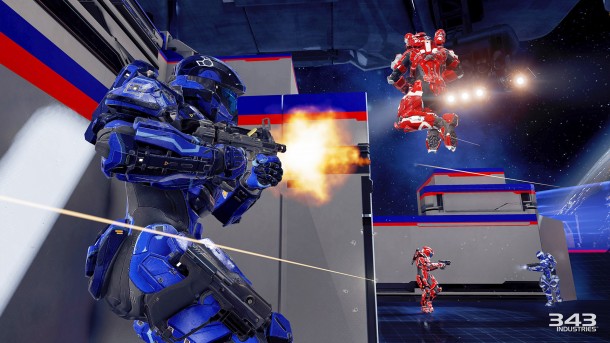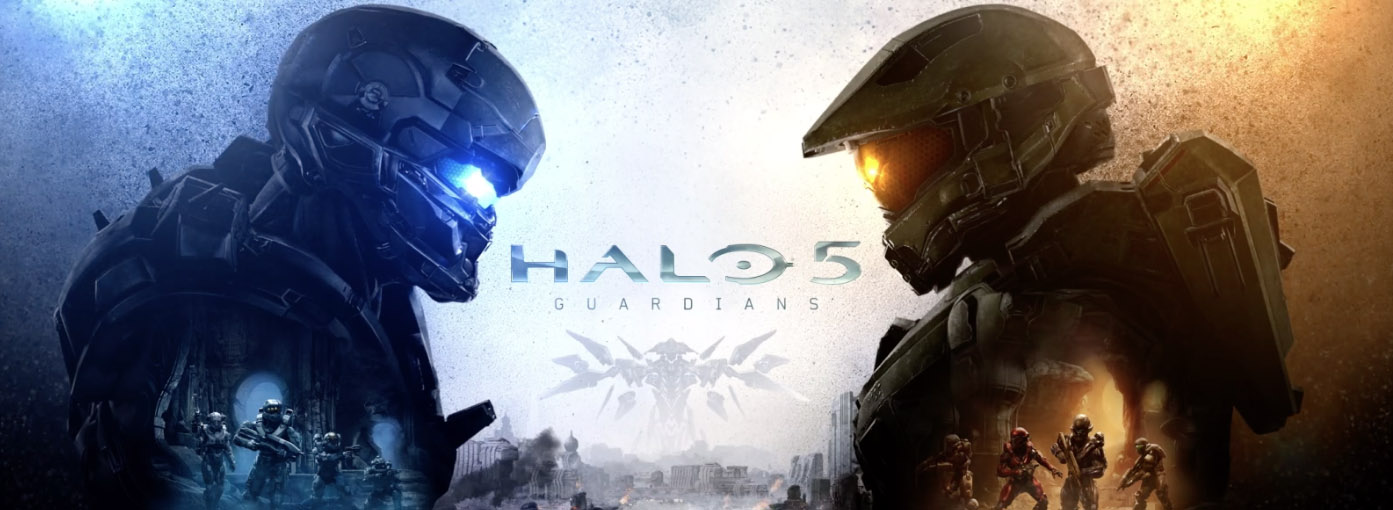Playing Halo 5: Guardians feels like coming home. The thing is, home isn’t always like you remembered.
Halo 5: Guardians represents a big moment for the Halo franchise. As the first installment on the Xbox One and as the sequel to the popular but divisive Halo 4, Guardians has a lot to prove. To do that, developer 343 Studios has tried to walk the line between evolving and growing the series and keeping longtime fans happy. Some of the changes are big, like splitting the singleplayer campaign between Master Chief and new character Jameson Locke, while others are more granular mechanical refinements. The end result is a game that can swing between being comfortably familiar and refreshingly new, or stale and too radically different.
While the advertising surrounding Guardians played up the angle of Locke hunting a rogue Master Chief, there’s very little of that in the campaign. In fact, there was little story at all. It’s strange, because what transpires in the story of Guardians is huge for the universe, but everything of real consequence happens in the last hour or so. Everything else is essentially: Locke looks for Chief, Locke finds Chief, Chief gets away, Locke looks and finds Chief again. I’m not saying every mission has to send shockwaves through the fiction, but the mistakes of Guardians’ grander story are harder to forgive when it fails to explore the more personal character-level interactions the way even something like ODST’s day-in-the-life story did.
That last hour or so, by the way, is painfully reminiscent of the infamous Halo 2 ending. They took a whole game doing what felt like little more than getting the story primed for the sequel, and that priming probably could have fit in the ending for Halo 4.

Despite 343’s stated emphasis on character development since taking over with Halo 4, everyone from Chief to Locke to their new accompanying squadmates are disappointingly underdeveloped.
Locke is another victim of the Halo franchise’s outsourcing of story to ancillary media. Maybe he was a fascinating and complex character when he starred in the Nightfall mini-series, but here he is just another by-the-book military guy character with an actor’s scanned face in cutscenes.
Chief, despite being the franchise star, doesn’t fare much better. Chief teams up with Blue Team, his closest Spartan-II friends from the books, in his search for Cortana. Unfortunately, Chief’s relationship with Cortana and Blue Team was little more than Cortana acting rampant, Blue Team asking Chief what to do, and Chief assuring them she would listen to him. There wasn’t much else, partly because the majority of the game is spent in control of Locke rather than Chief. Sure, what happens with Cortana in relation to the greater universe is big for the next game, but that deeper personal relationship between her and Chief that Halo 4 did so well in exploring is almost completely absent.
The inclusion of Blue Team feels like a sleight of hand trick to convince players that this game has good characters. Sure, I remember and liked them from the books, but I can’t remember a single thing any of them said within Guardians that wasn’t along the lines of “we should move up,” or “what’s that?” Aside from being named after characters you might have read about, they aren’t really any different from the story-invisible duplicate Chiefs you played as in the co-op modes of previous games.
As for Locke’s squadmates, If I hadn’t purchased the collector’s edition that comes with brief biography cards for the squad, I wouldn’t be able to tell you almost anything about the new teammates. Vale is vaguely bookish, Tanaka is somewhat sassy and tough, and Buck is Nathan Fillion.

I won’t lie though, even if some things were cheap or under-developed, as a longtime fan and a genuine sucker for Halo’s story, some things still really got me. They don’t talk much, but my heart skipped a beat when I realized I’d finally be fighting alongside Blue Team.
The squadmates have a bigger problem than being blank slates. Their inclusion is one of many signs that the campaign is tailor-made with cooperative play in mind, and going through it solo suffers for it notably.
Partly, that’s because the squad AI is as stupid as the Covenant Grunts. You can issue simple commands, go there, pick up that weapon or get in that vehicle, but that does little to help. When I ordered them to use a rocket launcher in the passenger seat of a Warthog they would stare blankly and refuse to take perfect shots at enemies. When I was downed and ordered them to pick me up with the new revive system, they would often run near me and then stand uselessly still before eventually deciding to help.
The other problem is that most enemy encounters are designed with four in mind. Taking on Hunters alone has changed from a slick way to feel like a badass to an exercise in frustration. New boss-like enemies encountered throughout the game exacerbate the problem. Like Hunters, they’re vulnerable in the back, but it was nearly impossible for me to get the AI to lure the enemies properly the way I could with human partners.
The levels themselves are huge, again obviously designed with lots of people in mind. The vehicle-focused levels are still a thrill ride, but I found many of the on-foot missions almost too big. On more than one occasion I was unsure of where to go and which group of enemies I should engage before I decided I could easily run past them and not have to worry about them at all as I progressed to the next checkpoint.
I should say that, however they play, the levels, and the rest of the game, are stunning to behold. The art design of Halo 4, heavy on the theme of Forerunner technology on pristine worlds brimming with life, dazzles with the modern power of the Xbox One and at 60 frames per second no less.
There’s also the interesting addition of a few non-combat levels where you can walk among NPCs and listen to them discuss the story’s events. I spent a good 15 minutes listening to one Grunt hilariously go on about everything from fighting against humans to how Grunts used to be more purple. These levels, and all the others, also have hidden audio-logs. They’re a pale shade of Halo 3’s excellent terminals, but at least you can listen to them in-game unlike Halo 4.
Even with all my complaints, when it got down to playing co-op with some friends, Guardians feels as good as ever. There’s the trademark Halo floaty-ness to the jumping, the player movement feels precise and tight, the battle rifle still has that satisfying three-round thump, it’s all there. Playing Guardians feels like riding a bike again.
That feeling is especially present in the competitive multiplayer Arena modes. Slayer, capture the flag, and more are still a joy to play. Stronghold and Breakout also join the roster. Stronghold is more or less Territories from Halo 3, while Breakout is a neat high-damage 4-on-4 mode that plays on unique maps with a Tron-like virtual vibe. Everything is tightly balanced thanks to ditching Halo 4 and Reach’s armor abilities and loadouts.
There are welcome new additions to the core running-and-gunning too. An unlimited sprint is available in every mode, no longer restricted to an armor ability. A thruster dodge, a powerslide, and the ability to climb up ledges and over obstacles make a big difference in bringing Halo up to speed a little with modern shooters.
That modernization also means you can now aim down the sights of every weapon, but doesn’t actually affect accuracy or bullet spread. Hardcore Halo traditionalists might say homogenization rather than modernization, as the added mobility and sight-shooting puts Guardians right in line with the quick and vertical Titanfall and Call of Duty: Advanced Warfare. But, in a world where ‘traditional’ Halo gameplay is preserved by the availability of The Master Chief Collection, I liked seeing 343 experiment a little and enjoyed the changes.

Although, there is one change in particular I’m having a hard time accepting. The motion detector that’s been an essential part of multiplayer combat now has a greatly reduced range. I’ve found enemies practically being within melee range before they showed up on radar. It’s a seemingly small change that makes a tremendous difference. There’s a whole different kind of situational awareness that has to be maintained. Your mileage may vary, but after 14 years of it being roughly the same, I’m not thrilled with having to adapt my playstyle in this way.
The biggest changes to multiplayer are the addition of the new Warzone mode and the requisition system that is so important to it.
Warzone pits players, 12 v.12, not only against each other, but NPC enemies as well. The core idea of the mode is similar to Battlefield’s conquest mode. Each team has their own base at opposite ends of several huge maps with three bases to capture in between. Teams gain points to win by holding bases and eliminating enemy players.
The key is that you also gain points from killing not just enemy players, but also cannon-fodder NPCs positioned at the bases and throughout the maps. Bosses, worth a sometimes huge amount of points, appear at different intervals, and included a powered-up Elite in a Wraith mortar tank, a Forerunner aircraft, a Promethean Knight and his soldiers, and more, and they require your team to work together to take them down.
That allows for dramatic swings that can result in thrilling and desperate last minute reversals or crackdown on the other team with a Mjolnir-armored fist and solidify your lead. It can also be frustrating when your team hammers a boss’s health all the way down and the other team gets all the points by making the last shot. Smartly, there’s always hope for victory even if the other team snipes all the bosses. If you can capture all three middle bases, the other team’s core becomes vulnerable and is an immediate victory if destroyed. The few occasions where I lead the charge or sneaked in on my own to heroically steal the win were the kind of dramatic finishes you dream about.
There’s also Warzone Assault, which is similar to Battlefield’s rush mode. Assault removes the NPCs and puts one team on attack and the other on defend. If a base is taken, the defenders fall back to another and try to stop the attackers. Three times and it’s up.
Warzone was by far the most fun I had with Guardians. It’s got all the best player-versus-player parts of Big Team Battle, my favorite mode from previous games, and the NPCs make it fun to contribute to your team even if you’re hitting a wall against other players.
Warzone is also where the requisition system comes into play. It’s a system similar to those used in many free-to-play games these days. You use points or real money to purchase req packs, which have a random assortment of weapons, vehicles, powerups, or customization options inside. Luckily for purists afraid of Warzone becoming a pay-to-win mode, the system is smartly balanced.
The biggest thing is that anything besides cosmetic options are usable only in Warzone. That means no powerups or anything in the traditional Arena. Experience points to buy req packs are also easy to gain. A gold pack costs either 10,000 points for $2.99. I was able to earn enough points after about an hour and a half of playing three matches of Warzone.
Reqs are also one-time use only. You can only summon anything in battle that you’ve gotten in a req pack, although everyone gets one free of each item when you first play. If I’ve req’d two Scorpion tanks in one battle and that’s all I had, I can’t summon a tank again until I randomly receive one in a pack.
Reqs also require points in-match to use. I’d have to earn enough points on my own, killing players or NPCs or capturing bases, to level-up high enough to use that Scorpion, and if it was destroyed after I used it, I’d have to get enough energy, again through points, to summon another.
It’s a simple but elegant way to keep people from buying their way to victory. I never felt like I was severely underpowered with the starting weapons, and was happy to take the power weapons off the dead hands of people who might have paid for them. It also helps that 343 has promised additional maps, for Arena modes and Warzone, will be free in the future. Diffusing that cost into optional purchases doesn’t strike me as much of a problem.
Guardians makes a lot of changes to the Halo formula, not all of them for the better, but I found myself enjoying it in spite of those problems. Even if the story doesn’t live up to the hype of the advertising or the potential of its universe, Guardians core gameplay and bountiful multiplayer modes will keep me coming back until it’s time to finish this trilogy’s fight.
This review is based on a retail copy of the game purchased by the reviewer.



No Comments